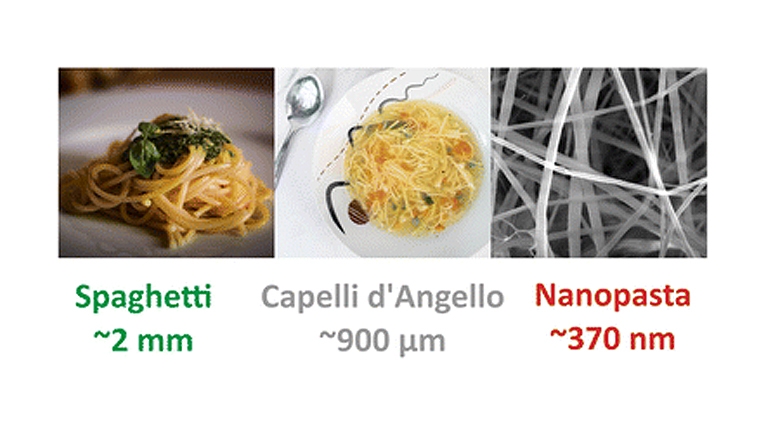
Science of all kinds can be utterly amazing, particularly so when looking at research with the realisation that you yourself could never have thought about it. Like making the finest, thinnest nanoscale "pasta", which is what researchers in the UK have done.
The researchers dissolved 17 per cent flour by weight in warm formic acid and cooled the solution, creating a thick liquid (which is called dope in the material sciences world) that can be processed via electrospinning. This process produces porous mats made of extremely fine fibres.
Said fibres are 372 nanometres in diameter, which is really thin compared to human hair at 60 to 100 microns. Somewhere between 160 to 270 times thinner.
Why make nanopasta though? It turns out that re-imagining good old starch in this manner has multiple exciting new applications:
"In conclusion, the electrospinning of wheat flour is possible from formic acid solutions, after ageing at 32 °C and cooling, forming mats of nanofibres with diameters of 372 (±138) nm. The formed mats are hydrophilic, and ideally positioned as a cheaper, greener replacement for starch in biodegradable, biosourced nanofibre applications, such as next generation bandaging, or carbonised supercapacitor electrodes."
Commercial starch production uses a great deal of energy and water.
With formic acid as a key ingredient and the properties of the flour possibly altered by the electro-spinning process, eating the pasta is most likely unwise; the recipe would have to be modified before the pasta could be incorporated into a Heston Blumenthal-like multi sensory molecular gastronomy experience.
However, the researchers say it is pasta, novel recipe notwithstanding:
"Additionally, as the newly developed material consists of fibres formed from the extrusion and drying of flour, it may be defined as pasta, dramatically undercutting the previous record for the thinnest pasta lunga by approximately a thousand times."
What's more, if you wondered what happens when you cook pasta, wonder no more:
"Cylindrical fibres of wheat are well established culturally and industrially, known as the pasta lunga subcategory of pasta. While pasta may be made from combining flour with egg (pasta fresca), most commonly it is produced as pasta secca (dry pasta), extruded from a water-flour mixture and dried under controlled atmosphere to a desired internal water content, typically 12 per cent, for long term storage.
These dried fibres are later refluxed in ∼0.1–0.3 M sodium chloride aqueous solution, leading to swelling of amylopectin lamellae and subsequent unwinding of the amylopectin helices upon hydration, facilitating digestion."
Hat tip to Becky Ferreira at 404media.co.

We welcome your comments below. If you are not already registered, please register to comment
Remember we welcome robust, respectful and insightful debate. We don't welcome abusive or defamatory comments and will de-register those repeatedly making such comments. Our current comment policy is here.